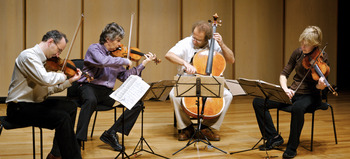Three's a magic number in Takács concert at Rackham Auditorium
Four’s company in quartet playing, but 3 — or even 2 — can be enough of a crowd with the right string players and repertoire.

Takács Quartet promotional photo
Photo by Richard Houghton
If there’s a quartet out there to prove it, it’s the Takács, which did so neatly enough Monday evening at Rackham Auditorium in a concert presented by the University Musical Society. Short a second violinist — Karoly Schranz is out for now, with rotator cuff surgery — Takács first violinist Edward Dusinberre, violist Geraldine Walther and cellist Andras Fejer regrouped for a program of duos and trios that don’t get much airing when 4’s the norm.
Since Ann Arbor audiences are old friends with the Takács, which happily visits almost yearly, what was particularly delightful about this program of Mozart, Kodaly and Beethoven was the chance to get up close and personal with the players. In the Mozart B-flat Duo for Violin and Viola, for example, you could really focus on violist Walther’s warm, vibrant sound in a way that just doesn’t happen when she’s the middle voice in a string sandwich. Here she was the foundation of this charming piece, just as cellist Fejer was in the gutsy, gorgeous, folk-influenced Kodaly Duo for Violin and Cello, Op. 7, that followed.
Meanwhile, Dusinberre, the man with the most prominent melodies as first violin, also proved to be a marvelous master of ceremonies, delivering brief, informative and amusing program notes before each piece that really hit the spot (and beat the heck out of the usual printed prose).
In short, the 3 players made Rackham a more intimate place than it usually is. The concert made me realize how rare it’s become in recent seasons to hear fewer than 4 on its stage.
Not that we won’t welcome the return of all 4 players of the Takács next season, when UMS has promised to bring them back. But 3 did the work of 4 in the Beethoven String Trio in G Major, Op. 9, No. 1, with Dusinberre cheerfully demonstrating how Beethoven gives the violin lots of double stops (2 notes to play at once) — a sort of legerdemain that makes up for an absent second violin.
Knowing the trade secrets added to the pleasure of this zestful work, and its jet-powered finale was as witty as it was thrilling, filled with unexpected turns and sudden straightenings of the road that made the ride tremendous fun.
Susan Isaacs Nisbett is a free-lance writer who covers classical music and dance for AnnArbor.com.
Takács Quartet performing Beethoven: String Quartet No. 14 live this fall:

